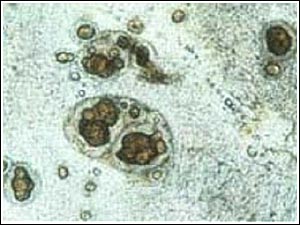

 |
||||||||||||
 |
||||||||||||
| Cryptobia iubilans in Cichlids | ||||||
| Page 2 of 3 | Pages: 1 . 2 . 3 | |||||
Comparing Cryptobia and Spironucleus infections Clinical Disease: Both Cryptobia and Spironucleus can result in similar disease scenarios on cichlid farms. Both parasites become more serious under conditions of crowding, poor sanitation, high organic load, and handling stress. Diet also may play a role in the development of the disease. It has been demonstrated in laboratory mice that changes in the intestinal bacterial flora, caused by changes in diet, can affect the presence of intestinal flagellates, suggesting greater potential for clinical disease. Enteric disease from either parasite may result in low level chronic mortality, "wasting" or poor growth. The effect of Spirtonucleus is more serious in fry and very young fish. It is not known if this is also true for Cryptobia, but there is some evidence that supports this belief. The impact of either disease on reproduction is not well understood; however, we believe that breeders heavily infected with Spironucleus produce poor quality eggs and weak fry. Diagnosis: Spironucleus can be tentatively identified by observing the motile trophozoites in smears of intestinal contents or feces. Identifying the parasite to genus requires both transmission and scanning electron microscopy and therefore cannot be done on a routine basis. Cryptobia is most easily detected by identification of granulomas in thin wet mounts of stomach tissue (Figure 1). Because these granulomas are indistinguishable from the granulomas observed with Mycobacterium, an acid-fast stain (eg. Ziehl-Nielson) should be used to rule out that important disease (see IFAS Extension Fact Sheet No. VM-96). In most instances, motile forms of Cryptobia will not be seen on wet mounts that are examined with a light microscope. Electron microscopy is also required to confirm the identity of this organism.  Figure 1: Typical granuloma seen in a wet mount of stomach tissue from an African cichlid with Cryptobia iubilans infection. The section is unstained and is examined with a light microscope (100x)
Figure 1: Typical granuloma seen in a wet mount of stomach tissue from an African cichlid with Cryptobia iubilans infection. The section is unstained and is examined with a light microscope (100x)
Transmission: Both Spironucleus and Cryptobia have direct life cycles. Infective forms are shed with feces, and ingestion of these forms is thought to result in infection. Both organisms can live in the water column for at least a few hours. Always remove carcasses as quickly as possible when they are found, since both parasites may be spread by ingestion of infected tissue. more ... |
 |
|||||
| About Us :: Message Board :: Chat | |||||
| Library :: Photo Gallery :: Links & Resources :: Breeders & Sponsors :: Merchandise | |||||
| Website designed by: EthanCote.com | © 2001-2004, SimplyDiscus.com. All Rights Reserved. | ||||